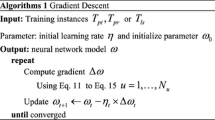Abstract
Adequate evaluation of an information retrieval system to estimate future performance is a crucial task. Area under the ROC curve (AUC) is widely used to evaluate the generalization of a retrieval system. However, the objective function optimized in many retrieval systems is the error rate and not the AUC value. This paper provides an efficient and effective non-linear approach to optimize AUC using additive regression trees, with a special emphasis on the use of multi-class AUC (MAUC) because multiple relevance levels are widely used in many ranking applications. Compared to a conventional linear approach, the performance of the non-linear approach is comparable on binary-relevance benchmark datasets and is better on multi-relevance benchmark datasets.
Access this chapter
Tax calculation will be finalised at checkout
Purchases are for personal use only
Similar content being viewed by others
References
Burges, C., Shaked, T., Renshaw, E., Lazier, A., Deeds, M., Hamilton, N., Hullender, G.: Learning to rank using gradient descent. In: Proceedings of the 22Nd International Conference on Machine Learning ICML 2005, pp. 89–96. ACM, New York (2005)
Burges, C.J.: From ranknet to lambdarank to lambdamart: An overview. Learning 11, 23–581 (2010)
Calders, T., Jaroszewicz, S.: Efficient AUC optimization for classification. In: Kok, J.N., Koronacki, J., Lopez de Mantaras, R., Matwin, S., Mladenič, D., Skowron, A. (eds.) PKDD 2007. LNCS (LNAI), vol. 4702, pp. 42–53. Springer, Heidelberg (2007)
Chapelle, O., Chang, Y.: Yahoo! learning to rank challenge overview (2011)
Cortes, C., Mohri, M.: AUC optimization vs. error rate minimization. Adv. Neural Inf. Process. Syst. 16(16), 313–320 (2004)
Donmez, P., Svore, K., Burges, C.J.: On the optimality of lambdarank. Technical Report MSR-TR-2008-179, Microsoft Research, November 2008. http://research.microsoft.com/apps/pubs/default.aspx?id=76530
Fawcett, T.: An introduction to ROC analysis. Pattern Recogn. Lett. 27(8), 861–874 (2006)
Ganjisaffar, Y., Caruana, R., Lopes, C.V.: Bagging gradient-boosted trees for high precision, low variance ranking models. In: Proceedings of the 34th international ACM SIGIR conference on Research and development in Information Retrieval, pp. 85–94. ACM (2011)
Joachims, T.: A support vector method for multivariate performance measures. In: Proceedings of the 22Nd International Conference on Machine Learning, pp. 377–384. ACM, New York (2005)
Manning, C., Raghavan, P., Schütze, H.: Introduction to Information Retrieval. Cambridge University Press, Cambridge (2008)
Microsoft learning to rank datasets. http://research.microsoft.com/en-us/projects/mslr/
Qin, T., Liu, T.: Introducing LETOR 4.0 datasets. CoRR abs/1306.2597 (2013). http://arxiv.org/abs/1306.2597
Qin, T., Liu, T.Y., Xu, J., Li, H.: Letor: A benchmark collection for researchon learning to rank for information retrieval. Inf. Retr. 13(4), 346–374 (2010). http://dx.doi.org/10.1007/s10791-009-9123-y
Svore, K.M., Volkovs, M.N., Burges, C.J.: Learning to rank with multiple objective functions. In: Proceedings of the 20th International Conference on World Wide Web, pp. 367–376. ACM (2011)
Wu, Q., Burges, C.J., Svore, K.M., Gao, J.: Adapting boosting for information retrieval measures. Inf. Retrieval 13(3), 254–270 (2010)
Acknowledgements
Thank you to Dwi Sianto Mansjur for giving helpful guidance and providing valuable comments about this paper.
Author information
Authors and Affiliations
Corresponding author
Editor information
Editors and Affiliations
Rights and permissions
Copyright information
© 2016 Springer International Publishing Switzerland
About this paper
Cite this paper
Welleck, S.J. (2016). Efficient AUC Optimization for Information Ranking Applications. In: Ferro, N., et al. Advances in Information Retrieval. ECIR 2016. Lecture Notes in Computer Science(), vol 9626. Springer, Cham. https://doi.org/10.1007/978-3-319-30671-1_12
Download citation
DOI: https://doi.org/10.1007/978-3-319-30671-1_12
Publisher Name: Springer, Cham
Print ISBN: 978-3-319-30670-4
Online ISBN: 978-3-319-30671-1
eBook Packages: Computer ScienceComputer Science (R0)




